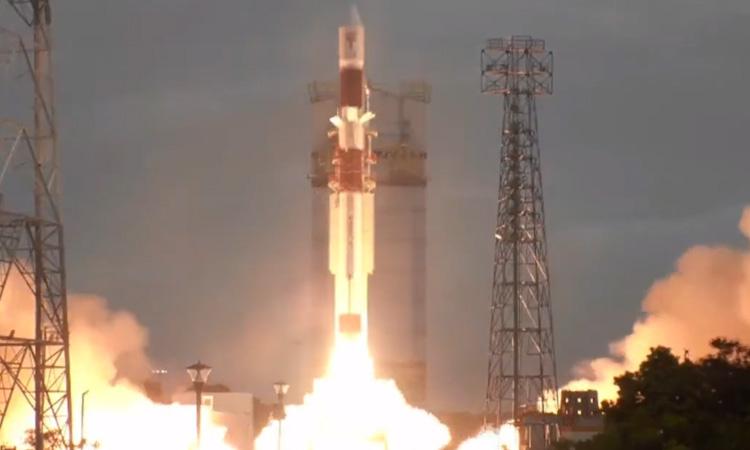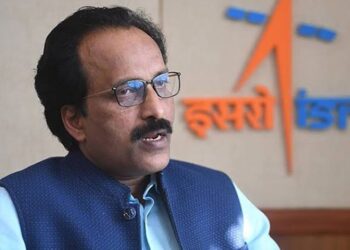On Sunday morning, India successfully launched seven satellites from Singapore, including the radar imaging satellite DS-SAR and six others.
This time, the Indian rocket Polar Satellite Launch Vehicle (PSLV) Core Alone took the honors.
Since 1999, the Indian Space Research Organisation (ISRO) has orbited 431 foreign spacecraft from 36 different countries.
After the launch and orbit placing, Indian Space Research Organisation (ISRO) Chairman S.Somanath said: “The seven satellites have been placed in a perfect orbit. Further exciting action with regard to the final stage of the rocket will soon happen, that is, bringing it down to 300 km to address the space debris issue. The process would take about 1.30 hours. There will be another rocket mission in August or early September.”
The 44.4-metre-tall PSLV Core Alone version rocket, codenamed PSLV-C56, lifted off from the first launch pad at the Satish Dhawan Space Centre (SDSC) here at 6.30 a.m. and steadily ascended up into the heavens.
The rocket, carrying the 352 kg synthetic aperture radar satellite DS-SAR as the principal passenger and six other tiny satellites as piggybacks, took off at 6.30 a.m. from the first launch pad at Satish Dhawan Space Centre (SDSC) here.
The other six satellites are the 23 kg VELOX-AM, ARCADE (24 kg), and SCOOB-II-4kg from Nanyang Technological University in Singapore, the 3 kg NuLIoN from NuSpace Pte Ltd in Singapore, the 3.5 kilogram Galassia-2 from the National University of Singapore, and the 13 kg ORB-12 STRIDER from Aliena Pte. Ltd., Singapore.
Cumulatively, the seven satellites weighed 422.5 kg.
NewSpace India Ltd, the commercial arm of India’s Department of Space, made the rocket launch on Sunday feasible by contracting principally with ST-Engineering to orbit the DS-SAR satellite.
ISRO deorbiting or bringing down the rocket’s fourth stage to low earth orbit (LEO) using the remaining fuel to shorten its orbital life is one of the mission’s standout aspects.
Solid (first and third stages) and liquid (second and fourth stages) fuels alternately power the PSLV rocket.
In its standard design, the PSLV is a four-stage/engine expendable rocket powered by solid and liquid fuels, with booster motors strapped to the first stage to provide additional thrust during the early flight minutes.
Because the total weight of the satellites was minimal, the rocket that flew on Sunday was the Core Alone model, which did not have any strap-on motors.
The PSLV-C56 ejected the DS-SAR satellite just over 21 minutes into its mission. It was followed by six further satellites.
The Indian rocket orbited all seven satellites in around 24 minutes after liftoff.
The DS-SAR satellite is being built in collaboration with DSTA (representing the Singapore government) and ST Engineering.
Once installed and operational, it will be utilized to support the satellite imagery needs of various agencies within the Singapore government.
ST Engineering plans to use it for multi-modal and high-resolution images and GIS services for its commercial customers.
The DS-SAR satellite is equipped with a Synthetic Aperture Radar (SAR) payload produced by Israel Aerospace Industries (IAI). This enables the DS-SAR to provide all-weather day and night coverage, as well as imaging at one metre resolution with full polarimetry.
The VELOX-AM, on the other hand, is a technology demonstration microsatellite; the ARCADE Atmospheric Coupling and Dynamics Explorer (ARCADE) is an experimental satellite; and the SCOOB-II, a 3U nanosatellite carrying a technology demonstrator payload: NuLIoN by NuSpace is an innovative 3U nanosatellite that enables seamless IoT connectivity in both urban and remote settings; Galassia-2, a 3U nanosatellite that will orbit in low earth orbit; and the ORB-12 STRIDER satellite, which is being built in conjunction with ISRO said.
The rocket launch on Sunday was ISRO’s second in nearly two weeks. The ISRO rocket LVM3 launched the Chandrayaan-3 satellite into orbit on July 14.
The Indian Space Research Organization has planned a series of rocket missions for 2023.
The next one in the mission to the Sun. ISRO will launch its Aditya L1 coronagraphy satellite on a PSLV rocket around the end of August to explore the solar atmosphere.
According to ISRO, the spacecraft will be positioned in a halo orbit around the Sun-Earth system’s initial Lagrange point, L1.
The satellite orbiting the L1 point has the significant benefit of continuously observing the Sun without occultation or eclipse.
The Aditya L1 mission is slated to happen a couple of days after ISRO attempts to land on the lunar soil its lander that is being carried by the Chandrayaan-3 spacecraft.
Following that, the orbiting of the Anwesha satellite and the XPoSAT- an X-Ray Polarimeter Satellite- will occur.
According to the government, it will be the country’s first specialized polarimetry mission to study the behavior of intense astronomical X-ray sources in harsh conditions.
The PSLV rocket is scheduled to launch the Radar Imaging Satellite-RISAT-1B in 2023.
The Indian space agency intends to orbit INSAT-3DS and two IDRSS (Indian Data Relay Satellite System) satellites using its Geosynchronous Satellite Launch Vehicle (GSLV).
Aside from these rocket trips, ISRO will be testing the numerous systems that will be installed in its LVM3 rocket for the first human space voyage.
Source:IANS







 Finance
Finance







